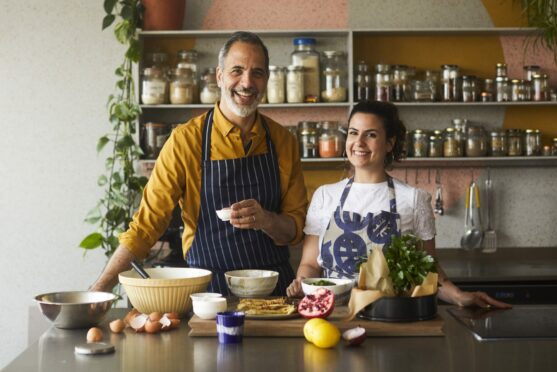
Ottolenghi’s Test Kitchen – a buzzing hub of food creativity, brought together by Yotam Ottolenghi – sounds like some kind of culinary utopia.
The OTK, as it’s lovingly known, headed up by fellow chef Noor Murad, 32, is where the new Ottolenghi recipes are dreamed up – and a few kitchen mishaps are encountered.
“Exploding aubergines” are not unfamiliar in the OTK, shares Ottolenghi.
“When you cook an aubergine without cutting it, there is a chance you’re going to get steam inside the skin, and then it kind of pops,” said the Israeli-born British chef. “And if it’s further down the line, it is a big pop. Personally at home, and I think one or two times in the Test Kitchen, we have had this.
“It’s fine if it’s in the oven, because you just need to clean the oven. But if it’s on the stovetop, it’s the whole kitchen that’s covered in bits of aubergine.”
The moral of the story? “Pierce your aubergines before you start cooking them, if you cook them whole,” the 53-year-old urged.
Aubergines are a classic ingredient in the Ottolenghi repertoire, joining the likes of kohlrabi and za’atar in the latest book co-authored with Murad, Ottolenghi Test Kitchen: Extra Good Things, a follow-up to the first OTK book in 2021, Shelf Love.
“Where Shelf Love was all about stripping your shelves, Extra Good Things is all about filling them back up with all the different condiments and sauces, sprinkles and pickles that you can use to accessorise your meals,” said Murad. “I feel like extra things are super-relevant right now.
“It’s a way of bringing luxury to your table at home. So you can have beans on toast or scrambled eggs, or something really simple, but then you can elevate it with all these little flavour bombs.” Despite being around food and cooking all day, Murad still tries to make time for it after work. “I do still cook at home, because I’m quite health-conscious – it’s really, really simple food, something like a frittata or a soup,” she said. “Your palate is being assaulted all day with all these amazing flavours, then you almost need to calm it back down.”
Ottolenghi agreed entirely, although he’s even less inclined to cook after coming home from work.
“I pick – there are a lot of food leftovers from the kids, because kids never finish their meal,” he said. “Sometimes around 9.30pm I often think I’ll go to bed without dinner, because I’ve eaten all day – but there is this moment just before you’re about to go to bed, 9.30pm, 10pm, when you’re hungry. Then I often get a slice of cheese and pickle – I love that combination.”
Ottolenghi’s recipes tend to involve a few more ingredients than just cheese and pickle, and his style is so distinct that his name has even become a verb: ‘to Ottolenghify’.
He said: “It’s funny, because I knew it was used in a particular way – ‘Oh, let’s do Ottolenghi’ – but when Noor wrote the introduction to this book and she used the verb ‘to Ottolenghify’… I understood what she meant as soon as I read it.
“In some way, that means to inject something which is delicious but familiar with something which is a bit unfamiliar, and a bit of excitement.” So what would it mean if you were ‘to Noorify’ a dish? Or “to Noorish”, a play on “nourish”, as he dubbed it. Ottolenghi said: “There’s a lot of zing in the way Noor cooks, with acidity and with herbs. The other thing I love about the way Noor cooks is there’s always a nice little finishing touch that is above and beyond – it’s not just a garnish, it’s a very well thought-out garnish that rhymes with the flavour that is already in there.”
Ottolenghi Test Kitchen: Extra Good Things by Noor Murad and Yotam Ottolenghi, Ebury Press, £25, is available now. Photography by Elena Heatherwick.

Enjoy the convenience of having The Sunday Post delivered as a digital ePaper straight to your smartphone, tablet or computer.
Subscribe for only £5.49 a month and enjoy all the benefits of the printed paper as a digital replica.
Subscribe